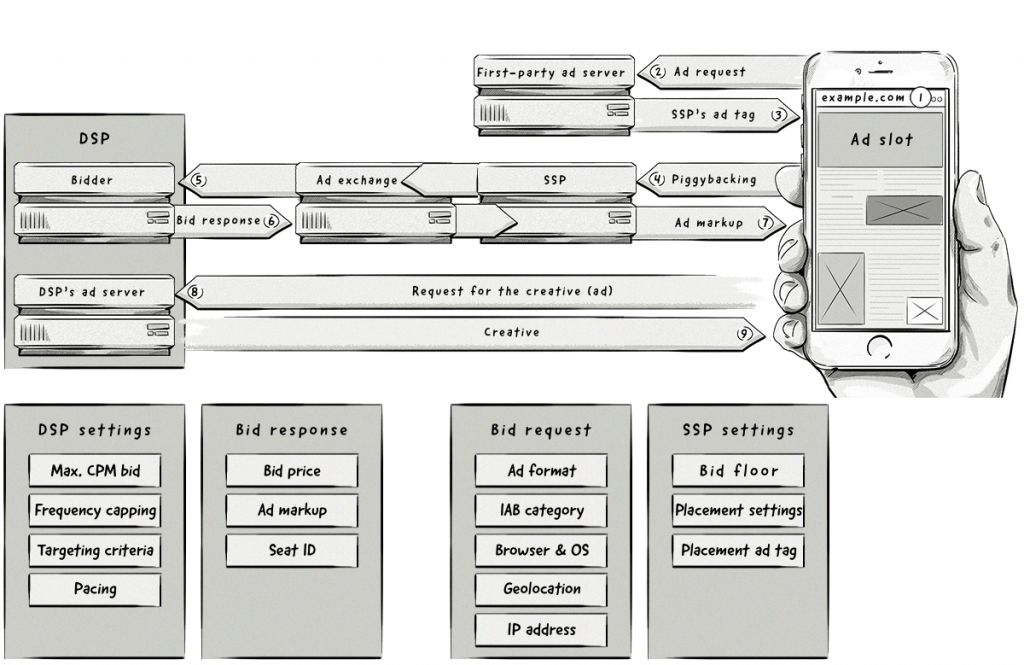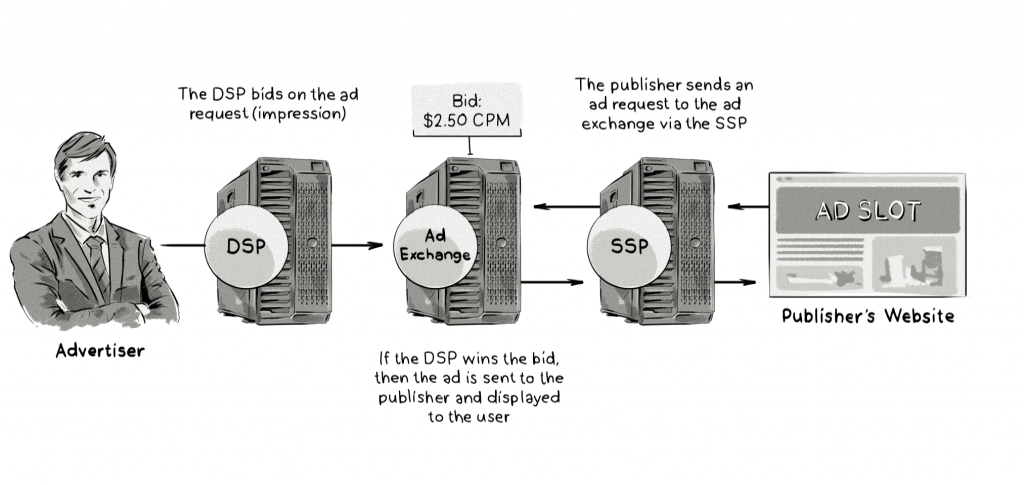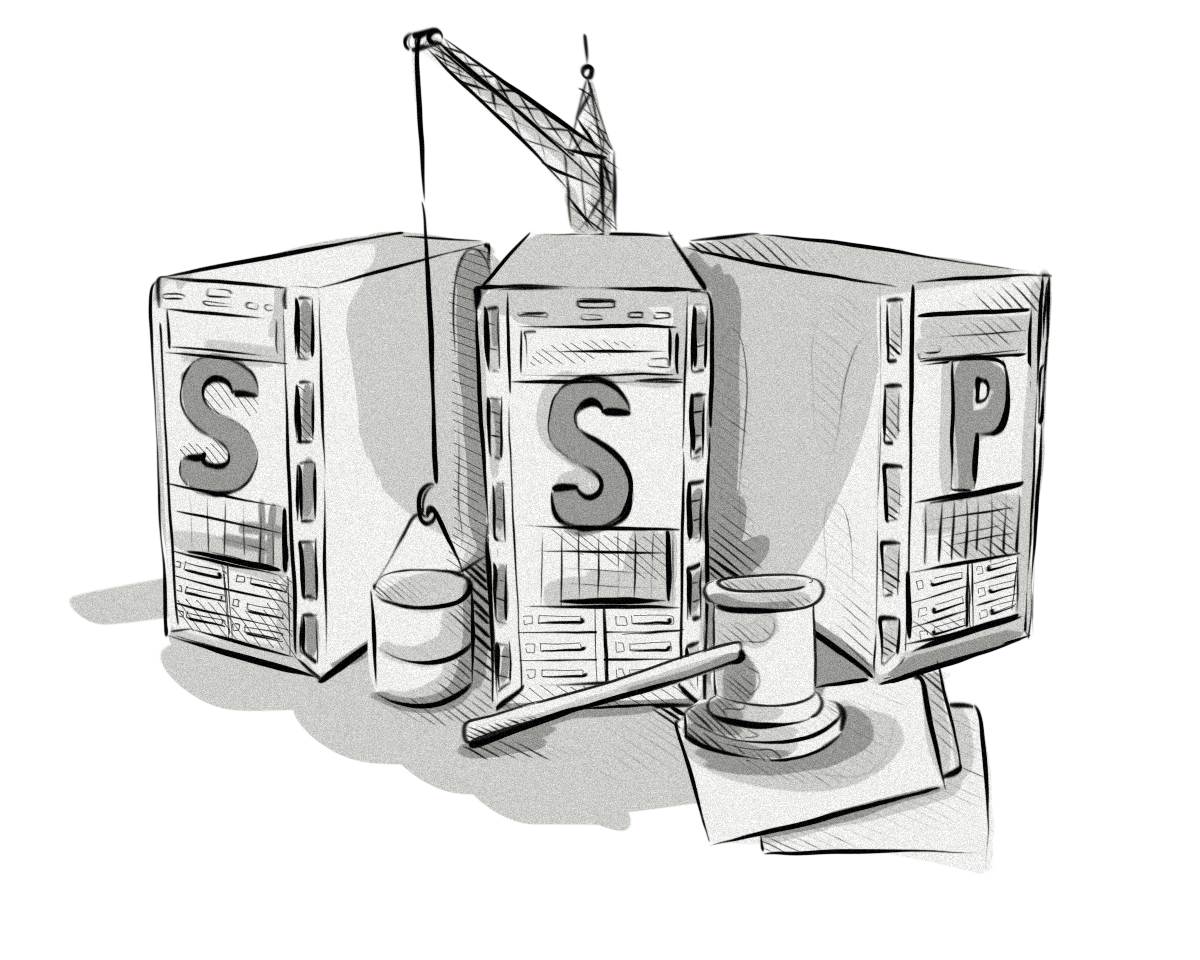Supply-side platforms (SSPs) and ad exchanges form the backbone of the online advertising industry, streamlining the process of digital ad selling and ad buying.
SSPs are crucial for publishers, facilitating real-time bidding for display, mobile, and video ads, advancing ad targeting, maximizing revenue, and offering in-depth analytics.
Ad exchanges, on the other hand, serve as digital marketplaces, bridging the gap between ad buyers and sellers and making real-time transactions possible.
In this article, we will shed light on the roles of SSPs and ad exchanges, explore instances where their development becomes beneficial, and provide a detailed walkthrough on how to design and build these platforms leveraging our extensive industry experience.
Key Points
- A supply-side platform (SSP) is an advertising technology platform digital publishers use to manage, sell, and optimize their advertising inventory. It automates the selling process, connecting publishers to multiple ad exchanges and demand-side platforms (DSPs).
- An ad exchange serves as a platform that streamlines the transaction of accessible ad impressions between advertisers, who bid through DSPs, and publishers, who offer their inventory via SSPs or directly through the ad exchange itself.
- SSPs and ad exchanges collaborate with each other in ad inventory buying and selling transactions. However, they are responsible for different processes.
- AdTech companies, publishers, brands, e-commerce platforms, and telcos can benefit from building an SSP and ad exchange.
- The key features of an SSP are header bidding, budgeting, frequency capping, ad targeting, macro support and override, inventory and campaign management and optimization, and reporting.
- The main challenges that companies face when building these platforms include scaling the infrastructure to handle changes in traffic volumes, incorporating accurate solutions for header bidding, and respecting privacy regulations and users’ privacy.
We Can Help You Build a Supply-Side Platform (SSP)
Our AdTech development teams can work with you to design, build, and maintain a custom-built supply-side platform (SSP) for any programmatic advertising channel.
What Is a Supply-Side Platform (SSP)?
A supply-side platform (SSP) is an advertising technology platform used by digital publishers to manage, sell, and optimize their advertising inventory (ad space). To streamline the process of selling ads, an SSP’s features include inventory and campaign management, yield optimization, header bidding, and analytics and reporting. SSPs allow publishers to monetize their websites, apps, or other digital platforms.
An SSP connects to multiple ad exchanges and demand-side platforms (DSPs) to maximize the exposure of a publisher’s ad inventory to potential buyers. It’s designed to help publishers get the highest possible ad prices through real-time bidding (RTB) auctions.

What Is an Ad Exchange?
An ad exchange serves as a platform that streamlines the transaction of accessible ad impressions between advertisers, who bid through DSPs, and publishers, who offer their inventory via SSPs or directly through the ad exchange itself.
The metaphor of a stock exchange is often used to describe ad exchanges due to the similarities between the trading processes of media space and stocks.
The whole process is conducted via real-time bidding (RTB).

What’s the Difference Between an SSP and Ad Exchange?
A supply-side platform (SSP) and an ad exchange are crucial components of the programmatic advertising ecosystem, but they serve different purposes.
An SSP is a platform publishers use to manage, sell, and optimize their available ad inventory. It automates the selling process, connecting publishers to multiple ad exchanges and demand-side platforms (DSPs).
An ad exchange is a digital marketplace where advertisers and publishers buy and sell ad space, often via real-time bidding. It facilitates these transactions, acting as a mediator between the buying and selling parties.
Ad exchanges connect to multiple DSPs and SSPs, ensuring a vast pool of advertisers and publishers can engage in the buying and selling of ad space.
SSPs are more publisher-focused, while ad exchanges serve both advertisers and publishers.
| SSP (Supply-Side Platform) | Ad Exchange |
|---|---|
| A platform that allows publishers to manage, sell, and optimize their available ad inventory. | A digital marketplace where advertisers and publishers buy and sell ad spaces, often through real-time bidding. |
| Used mainly by publishers to sell their ad inventory. | Used by both advertisers (to buy ad space) and publishers (to sell ad space). |
| Maximizes the exposure of a publisher’s ad inventory to potential buyers and optimizes revenue. | Facilitates the buying and selling of ad space in a real-time auction format. |
| Connects with multiple ad exchanges and DSPs. | Connects with multiple DSPs and SSPs. |
| Offers tools for publishers to understand and optimize their ad monetization strategies. | Generally, doesn’t offer optimization tools but conducts the transaction of ad spaces efficiently. |
How Do an SSP and Ad Exchange Work?
An SSP and an ad exchange work together in the AdTech ecosystem, streamlining the buying and selling of digital ad space.
This is how an SSP works:
- Publishers, such as website owners and app developers, link their digital properties with an SSP. They relay information about their available ad space or ad inventory to the SSP, detailing the size and type of ads they can host and their location on the website or app.
- The SSP collects this ad inventory data from all its associated publishers and offers it to potential buyers.
- When a user visits the publisher’s site or app, the SSP sends information about the user and the available ad space to the ad exchange.
This is how an ad exchange functions:
- The ad exchange receives information about the available ad space and user from the SSP.
- The advertiser or agency creates the campaign by setting the targeting, ad size etc.
- The DSP analyzes the bid request and then matches it with the information contained in the ad campaigns created by advertisers and ad agencies.
- The ad exchange holds a real-time auction for each ad impression. This process usually takes place within the few milliseconds it takes for a webpage to load.
- The highest bid wins the impression. The ad exchange then coordinates with the SSP to display the winning ad on the publisher’s site or app.

Who Can Benefit From Building an SSP or an Ad Exchange?
Building an SSP can provide a few benefits for AdTech companies, publishers, brands, e-commerce platforms, and telcos. Below we briefly discuss the main benefits for these parties.
AdTech Companies
Building an SSP can generate more income for AdTech companies, as they earn money from transaction fees every time an ad is bought or sold on their platform. The more transactions, the more revenue they earn.
An SSP can also help AdTech companies grow their business as it can attract publishers who want to sell ad space and, as a result, brings in more advertisers. So, it helps expand their business by attracting more clients.
SSPs also provide valuable data about ads, user behavior, and market trends. This information can help AdTech companies improve their products, create new services, and better service their clients.
Publishers
Publishers can benefit from an SSP in a few ways. First, they can automate inventory sales across multiple formats and devices, reducing manual work and enabling them to monetize their sites or apps effectively.
SSPs provide detailed reports, offering insights into bidding processes, inventory value, and advertiser behavior. They can also connect with multiple networks, ad exchanges, and DSPs, attracting more buyers and potentially enhancing yield.
Furthermore, SSPs implement price floors, ensuring inventory isn’t undersold and assisting in yield optimization. Some platforms employ a blend of soft- and hard-price floors, creating a hybrid auction model.
SSPs also boost brand safety by filtering out unwanted ads, providing publishers the ability to control which ads appear on their sites.
Ad Agencies
For large brands and ad agencies, creating their own ad exchange can offer many benefits — from boosting ROI to improving campaign results to cutting costs.
An ad exchange imparts greater control over the displaying of ads, data collection, and ad delivery, allowing the agency to define client-centric metrics and criteria, hence improving results.
Also, ad agencies can build their own ad exchange to replace their existing third-party AdTech platforms, which will not only give them more control over the tech but also allow them to reduce the fees and commissions paid to third-party tools.
An ad exchange can also enable agencies to access valuable data sets on user behavior, which helps improve targeting and campaign performance.
Main Challenges When Building an SSP and an Ad Exchange
Let’s take a look at challenges that are typically encountered when designing and building a supply-side platform (SSP) and ad exchange.
Achieving Scalability
SSPs and ad exchanges must be capable of processing billions of daily requests. This requires a platform that can scale dynamically to manage increasing or decreasing traffic without compromising on speed or reliability.
The key factors to consider when designing for scalability include:
- The platform’s ability to handle peak traffic loads.
- Its capacity to manage the continuous stream of bid requests and responses.
- Its ability to store and process vast amounts of data.
- Its adaptability to rapid changes in demand.
- Its ability to anticipate and accommodate potential growth in terms of user base, the number of partners, and the volume of data processed.
- Acceptable cost per transaction.
To avoid downtimes and build a scalable SSP and ad exchange, a well-designed architecture is required, as well as a robust server infrastructure, optimized cloud-computing solutions, and efficient data handling and storage systems.
Implementing Real-Time Bidding
The success of the real-time bidding (RTB) process lies in the ability of the platform to facilitate a real-time auction for each ad impression as a webpage is loaded. Each auction takes place within milliseconds, meaning that carrying out this process adds a lot of technical complexity.
The key factors to consider when designing the RTB system include:
- Selecting the right technologies to ensure seamless communication between the SSP, DSP, and the ad exchange.
- Handling the collection and processing of data involved in the real-time bidding process, such as the bid request, the actual bids, and the bid response
- Implementing algorithms that optimize the process of displaying the best-performing creative based on data.
User Data Privacy
As both SSPs and ad exchanges often collect and process user data when running targeted advertising, it is essential to balance effective ad personalization with user privacy.
From the technological point of view, the first step towards making SSPs and ad exchanges compliant with regulations such as GDPR and CCPA involves ensuring accurate collection and transmission of user consent information from publishers and between tech platforms. However, to follow the rules entirely, platforms need to adapt certain technological solutions, such as encryption and other PETs, to protect user data.
Some examples of privacy-enhancing technologies include:
- Minimization techniques
- Encryption
- Anonymization/pseudonymization
- Virtual Private Networks (VPNs)
- Privacy-preserving APIs
- Trusted execution environment (TEE)
- On-device learning/federated learning (FL)
- Privacy-preserving data mining (PPDM)
- Differential privacy (DP)
- Homomorphic encryption (HE)
- Multi-party computation (MPC)
We covered PETs in more detail in the blog post What are Privacy-Enhancing Technologies (PET) in AdTech?, where you can learn more about how they are being used in AdTech today.
How to Design and Build an SSP or Ad Exchange?
Developing a supply-side platform and ad exchange is a task that involves several steps. Below are the phases we at Clearcode follow to build SSPs, ad exchanges and other digital advertising software.
Discovery
This phase includes:
- Understanding the objectives, vision, and context of your SSP or ad exchange development project.
- Identifying your project’s initial requirements and potential technical challenges associated with real-time bidding and data processing.
- Answering various technical questions that surface during this phase, such as ensuring scalability and data privacy compliance.
Sprint 0
This phase includes:
- Identifying the technical unknowns of the SSP or ad exchange development project and exploring potential solutions.
- Selecting the features for the minimum viable product (MVP) and creating a list of user stories that will constitute and shape the product backlog.
- Researching the optimal tech stack and infrastructure architecture for efficient ad serving and real-time auctions.
- Conducting initial research for MVP development or proof of concept (PoC) development.
MVP Development
This phase includes:
- Building your SSP or ad exchange’s MVP — encompassing front-end and back-end development, infrastructure setup, UX/UI design, and thorough quality assurance testing.
- Launching your MVP to initial users or stakeholders, typically a select group of publishers and advertisers.
- Gathering feedback for the post-MVP development phase, focusing on aspects such as the user experience, ad serving efficiency, and reporting features.
- Monitoring the platform’s performance, ensuring smooth operations, and responding to any unforeseen emergencies.
Post-MVP Development and Maintenance
This phase includes:
- Continuing the development of the SSP or ad exchange via our agile development process (2-week sprints), aiming to provide new or improved features at the end of each sprint, such as advanced targeting options or enhanced analytics capabilities.
- Providing ongoing support and maintenance of the software and infrastructure, ensuring high availability and addressing any issues promptly.
- Transitioning the project to your internal team if required, including comprehensive training on managing and maintaining the SSP or ad exchange.
Examples of SSPs and Ad Exchanges that Clearcode has Built
Over the years, Clearcode’s AdTech & MarTech development teams have designed, built and delivered various SSPs and ad exchanges for AdTech companies, publishers, media companies, and ad agencies.
Below you’ll find short descriptions and links to two projects we’ve worked on.
A Scalable SSP
Clearcode designed and built an SSP with the goal of solving key challenges around performance and scalability. The SSP incorporated an ad exchange component and was designed to help companies decrease development time when building a supply-side platform (SSP) or ad exchange.
We deployed a microservice architecture and coupled it with a horizontal scaling pattern to overcome the scalability challenge. By introducing inter-service communication over the publish-subscribe (pub/sub) layer and developing a populator service, we managed to handle the challenges associated with an SSP’s performance.
As a result, the ad exchange has stable performance, is scalable, is able to sell more inventory to DSPs, and has the most up-to-date inventory.
Supply-Side Platform (SSP), Ad Exchange and Prebid Adapter Development for FatTail
FatTail, a leading US-based AdTech company, collaborated with Clearcode to create their AdBookPSP solution, establishing the first SSP specifically tailored for deal-based programmatic transactions.
The primary challenges included modifying the Prebid adapter to transmit all bids from the demand sources to Google Ad Manager, as opposed to the standard limit of 3, and gaining a thorough understanding of the integration process with Google Ad Manager.
Through incorporating deal instructions from AdBook+, executing real-time processing, integrating with the DSPs, carrying out decision-making, and finally, conducting post-RTB processing, we were able to create a one-of-a-kind custom solution.
We Can Help You Build a Supply-Side Platform (SSP)
Our AdTech development teams can work with you to design, build, and maintain a custom-built supply-side platform (SSP) for any programmatic advertising channel.








